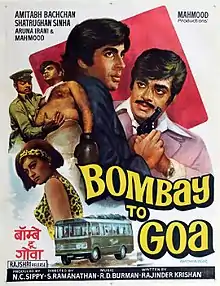Bombay to Goa
Bombay to Goa is a 1972 Indian road comedy film directed by S. Ramanathan, starring Amitabh Bachchan and Aruna Irani in lead roles, Shatrughan Sinha as the main antagonist and Mehmood. The movie is known particularly for its catchy tunes.
| Bombay to Goa | |
|---|---|
 Film poster | |
| Directed by | Mehmood, S. Ramanathan |
| Produced by | Mehmood, N. C. Sippy |
| Written by | Rajinder Krishan (dialogue) Usalai Somanathan (story) |
| Starring | Amitabh Bachchan Aruna Irani Shatrughan Sinha Nazir Hussain Mehmood Anwar Ali |
| Music by | R. D. Burman |
| Cinematography | Jal Mistry |
| Edited by | A. Paul Durai Singham |
Production company | Mahmood Productions |
Release date | March 3, 1972 |
| Country | India |
| Language | Hindi |
| Box office | est. ₹ 1 crore (est. ₹ 27.2 crore as of 2019) [1] |
It was a "Super hit" At the box office. The film is a remake of a 1966 hit Tamil film Madras to Pondicherry.[2] The role played by Nagesh in Tamil version was reprised by Mehmood in the Hindi version.
Bombay to Goa was remade in 2007 with the same title, with an ensemble cast of comedians. It was reported that the 2004 Marathi movie Navra Maza Navsacha, which was also remade in Kannada in 2007 as Ekadantha was heavily inspired by this movie.[3]
The Hindu had reported that Rajiv Gandhi was offered the lead role by Mehmood but he had turned it down.[4]
Plot
The lives of Atmaram (Nazir Hussain) and his wife (Dulari) are turned upside down when they see their daughter, Mala's (Aruna Irani) pictures in a magazine. They arrange for Mala's marriage with the son of Ramlal (Agha). Mala is opposed to marrying anyone who she has not met, and is at the same time thrilled that the two persons she trusted, one Verma (Shatrughan Sinha), and the other Sharma (Manmohan) had actually submitted her pictures to a magazine, and were now willing to sign her up for a Bollywood movie. Mala is not able to understand her parents' opposition on her way to fame, and runs away from home with a lot of money and hands this money to Sharma and Verma. Greed overtakes Sharma and Verma, leading to the death of Verma. Mala, who witnessed Sharma kill Verma, now is on the run for her life. She boards a bus from Bombay which is bound for Goa. Sharma soon overtakes her, and has one of his armed men on the bus to kill her. And then arrives Mala's admirer Ravikumar (Amitabh Bachchan), who not only protects Mala, but also accompanies her throughout the journey. Mala starts to trust and subsequently fall in love with Ravikumar. The bus journey is adventurous with the passengers, a totally mixed bunch, from all over India, different religions, cultures, and faiths, all thrown together for this journey. The bus is in the "control" of driver Rajesh (Anwar Ali), and conductor, Khanna (Mehmood).hence she gets her love and the reality of her trusted people.
Bachchan's Big Break
Amitabh Bachchan has had an illustrious career that has spanned decades, but "Bombay to Goa" (1972) was his first film as the main lead. Bachchan had earlier worked in films but this film was his first as a lead hero because Saat Hindustani (1969) had 7 protagonists, Navin Nishchal was the lead hero in Parwana (1971) and Rajesh Khanna was main lead in Anand (also 1971). "Bombay to Goa" was followed by Zanjeer (1973) and after that followed the super-stardom of more than fifteen years. Bachchan was picked for his role in Zanjeer after Javed Akhtar saw him in this film. As per The Hindu the role was first offered to Rajiv Gandhi, when he had not started career in Indian politics.
Cast
- Mehmood as Khanna / Bus Conductor
- Anwar Ali as Rajesh / Bus Driver
- Shatrughan Sinha as Sharma
- Amitabh Bachchan as Ravi Kumar
- Aruna Irani as Mala
- Nazir Hussain as Atmaram, Mala's Father
- Dulari as Mala's Mother
- Manmohan as Verma
- Mukri as South Indian Passenger
- Randhir as Kader Bhai
- Sunder as Pandit
- Keshto Mukherjee as Sleeping bungala Passenger
- Manorama as Young Girl's Mother
- Yusuf Khan as Boxer - John Ragada
- Babbanlal Yadav as Boxer's Henchman
- Asit Sen as Dhaba Owner
- Lalita Pawar as Kashibai
- Birbal as Marathi yaar na miley Passenger
- Raj Kishore as Passenger
- Darshan Lal as Army man
- Parveen Paul as Ravi's mother
- Agha - Ramlal as Ravi's father
- Pakoda Kadhar as Pakoda Boy
- Kishore Kumar as Himself (Special Appearance)
- Mehmood Jr. as Dhaba Waiter (Special Appearance)
- Usha Iyer (Special appearance)
Trivia
Mehmood specially made this movie to launch his brother Anwar Ali and Amitabh Bachchan
Amitabh Bachchan pressured Shatrughan Sinha to do the villain's role, although he wasn't keen on doing it. He agreed only because of their close friendship from their struggling days.
Soundtrack
- "Dekha Na Haye Re" - Kishore Kumar
- "Tum Meri Zindagi Mein" - Kishore Kumar, Lata Mangeshkar
- "Listen To The Pouring Rain" - Usha Uthup
- "Dil Tera Hai Main Bhi Teri" - Lata Mangeshkar, Kishore Kumar
- "Haye Haye Yeh Thanda Paani" - Asha Bhosle
- "Yeh Mehki Mehki Thandi Hawa" - Kishore Kumar